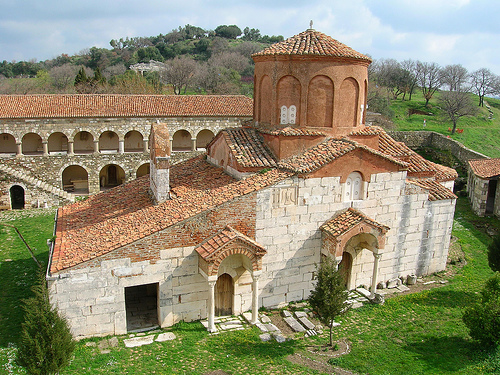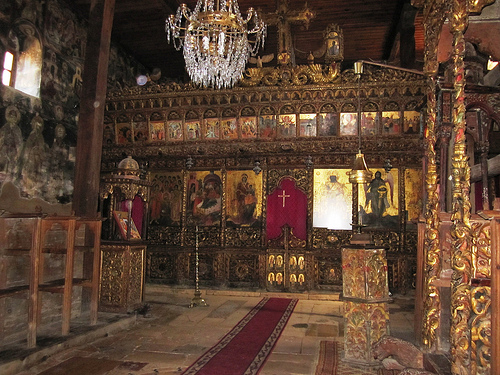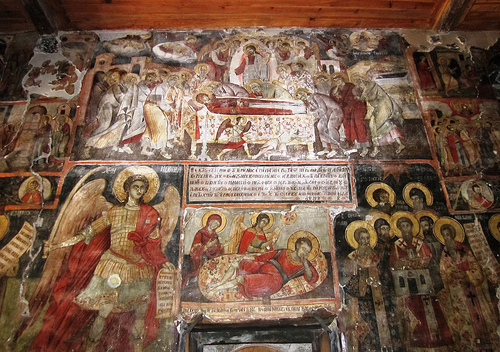


Ardenica Monastery was found in 1282 on the orders of Byzantine Emperor Andronikos II Palaiologos. The emperor recently defeated Capetian House of Anjou that ruled Sicily at the time during Siege of Berat (1280-81). To celebrate his victory and thank God Andronikos chose an ancient chapel of Holy Trinity that was erected on a site of an ancient pagan temple devoted to goddess Artemis. Some scholars suggested that the name "Ardenica" is a derivative of the name of Roman deity. Monastery held an important place in religious and political life of the country. It managed to gather a library of 32,000 books, much of these unfortunately were burned in a fire of 1932. Ardenica Monastery is still active and it is open to the public. It is common rule in the Orthodox monasteries to wear long pants for man and skirts for women.


Many of the frescoes are made by famous brothers Kostandin and Athanas Zografi in 1744.
It is believed that the Byzantine emperor Andronikos II had the
monastery built on the hill of Ardenica in 1282 and that this
foundation is linked to the emperor's victory over the Neapolitan
troops at Berat. A chapel dedicated to the Holy Trinity (Greek Αγία
Τριάδα, Albanian Shën Triadhë) has existed in the same place for at
least a century. The new main church was placed under the patronage
of the Mother of God.
There is a hypothesis that the chapel
was built on the foundations of an ancient temple that was dedicated
to the goddess Artemis. The modern place name Ardenica is said to be
derived from Artemis. In the vicinity of the monastery, ancient
building remains were actually found, which probably belonged to
thermal baths.
In an Ottoman Defter by Nahija Myzeqe from
1431/32, the village of Ardenica is named as a place with eight
taxable houses. In 1451 the famous Albanian prince Skanderbeg
married Donika Arianiti Muzaka in this monastery.
In 1743
Method, Bishop of Berat, who came from Bubullima in the Myzeqe, had
extensive renovations and extensions carried out in Ardenica.
Essentially, the current state of the monastery corresponds to this
last major construction phase in the 18th century.
Around the
same time, the cleric Nektarios Terpo (monk name Hieronymus) lived
in the Ardenica monastery. The learned monk wrote in Greek, Latin,
Albanian and Aromounic, and he also taught these languages to the
young monks of the monastery. In 1773 a textbook on religion was
printed by Terpo in Venice.
In 1780 Ardenica received a
Greek-language primary school; it was expanded to a grammar school
in 1817 and existed as such until shortly before the Second World
War. The monastery has been a center of higher education since the
17th century. It had a very extensive library, most recently 32,000
volumes. It contained not only titles from the Orthodox culture, but
also works from Western Europe, Hungary and Poland, which give
eloquent testimony to the extent to which the spiritual connections
of the monks reached in the 18th century. The Ardenica Monastery
obtained most of its book treasure from the trading town of
Voskopoja, which at that time was the most important cultural center
in the Balkans alongside Constantinople. In 1932 the entire Ardenica
library fell victim to a fire.
In 1967 the monastery was
forcibly dissolved by the communist rulers, but not destroyed like
so many other sacred buildings in Albania, but instead declared a
cultural monument and maintained as such. At the end of the 1980s,
the monastery complex was converted into a tourist hotel; the monks'
cells served as rooms. In 1992 the Orthodox Church of Albania got
the monastery back. Immediately afterwards, a priest was sent to
Ardenica to hold regular services again. It took years before the
outbuildings and lands were returned. A community of monks has been
living in the monastery again since the mid-1990s.
The monastery complex takes up an area of 2500 square meters. In
addition to the St. Mary church and the Trinity Chapel, the complex
includes several narrow buildings with the cells for the monks, an
oil mill, a bakery, stables and the gatehouse. The main church is a
basilica, which has all the usual rooms for the Byzantine church
type (exonarthex, narthex, naos, etc.). Most of the stones used to
build it come from the ruins of Apollonia, some 18 kilometers away.
The bell tower with an almost square floor plan is 24 meters high.
On the south side of the church there is an open portico, which is
spanned by round arches on short columns. The nave is divided into
three parts by two pairs of wooden columns.
Picture
decorations of the St. Mary church
The monastery church was
painted with frescoes in 1744 by Konstantin and Athanasios Zografi
from Korça, both of whom were also active in Voskopoja and on Mount
Athos. It depicts events from the life of the Mother of God and the
life of Jesus as well as the pouring out of the Holy Spirit on the
apostles on the day of Pentecost. Noteworthy among the images of
saints is a representation of the Byzantine musicologist and monk
Johannes Kukuzeli from Dyrrachion, of whom there are only a few
images. In the narthex, the entire east wall is covered by a
depiction of the Last Judgment.
The iconostasis was also
built in 1744. The woodwork indicates the craft school of Voskopoja.
The icons were created by Konstantin Shpataraku. On one of the holy
images there is also an image of the Albanian Prince Karl Thopia.
The ruler from the 14th century has a crown and scepter as
attributes. So he was remembered as a king four centuries later.